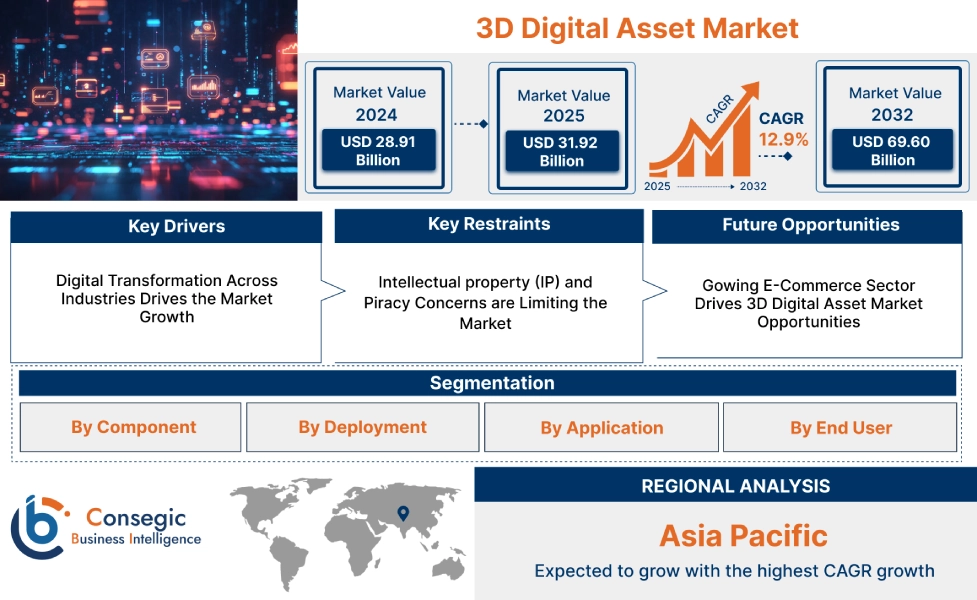3D Digital Asset Market Size:
3D Digital Asset Market is estimated to reach over USD 69.60 Billion by 2032 from a value of USD 28.91 Billion in 2024 and is projected to grow by USD 31.92 Billion in 2025, growing at a CAGR of 12.9% from 2025 to 2032.
3D Digital Asset Market Scope & Overview:
A 3D digital asset is a virtual object or model created in three dimensions using specialized software. It's used in various digital media like video games, films, and virtual reality to represent characters, environments, and objects. Further, key benefits of 3D digital assets include enhanced visualization, efficient prototyping, improved collaboration, and versatility across various applications from marketing to virtual reality. These benefits in turn result in saving time and costs while boosting creativity and engagement. Furthermore, key trends driving the market include increasing demand for immersive experiences in gaming and the metaverse, proliferation of virtual and augmented reality (VR/AR) technologies, and the growing integration of AI and machine learning to automate and streamline the creation of 3D content.
How is AI Impacting the 3D Digital Asset Market?
AI is profoundly impacting the market by automating and accelerating the creation process. Generative AI tools now allow users to create complex 3D models from simple text prompts, images, or sketches in a fraction of the time it would take a human artist. This not only reduces costs and skill barriers but also enables rapid prototyping and mass production of customizable assets. Furthermore, AI is used to automate tedious tasks like rigging and texturing, and to optimize models for different platforms, thereby streamlining workflows across industries such as gaming, e-commerce, and architecture.
3D Digital Asset Market Dynamics - (DRO) :
Key Drivers:
Digital Transformation Across Industries Drives the Market Growth
Digital transformation is a key driver as it compels industries to adopt modern technologies to remain competitive. Businesses are integrating 3D assets to enhance visualization, create immersive experiences, and streamline workflows. For instance, in manufacturing, 3D models are used for digital prototyping and simulations to reduce the time and cost associated with physical mockups. In architecture, they facilitate virtual walkthroughs, while in e-commerce, augmented reality (AR) product visualizations are used to boost customer engagement and sales. This widespread adoption across diverse sectors creates a growing demand for a wide range of high-quality 3D models.
- For instance, in June 2025, Siemens and NVIDIA expanded their partnership to accelerate the digital transformation of factories. They're combining Siemens' industrial software with NVIDIA's AI and accelerated computing to create the "factory of the future." The collaboration, which began in 2022 and has since expanded to include generative AI and robotics, allows manufacturers to use AI-powered automation from design to execution.
Thus, enhanced visualization, immersive experiences and streamlined workflows drive the 3D digital asset market size.
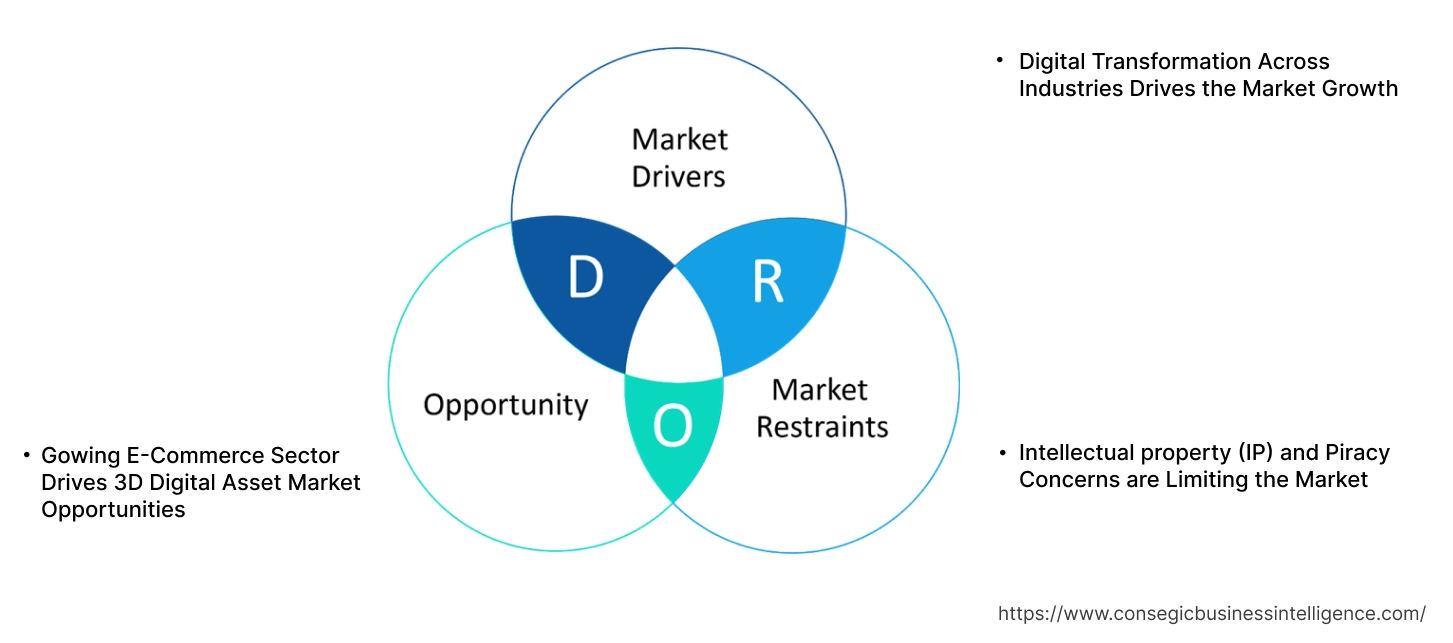
Key Restraints :
Intellectual property (IP) and Piracy Concerns are Limiting the Market
Intellectual property (IP) and piracy concerns are significant restraints on the 3D digital asset market, as the ease of copying and distributing digital files can devalue creators' work and reduce revenue for businesses. The decentralized nature of digital content makes it challenging to enforce copyright and licensing agreements, leading to unauthorized use and sales of high-quality assets. This not only causes economic losses for creators but also discourages investment in the creation of premium content. The lack of a robust, universally adopted system for digital rights management makes it difficult to protect against theft, thereby limiting market growth and innovation.
Future Opportunities :
Gowing E-Commerce Sector Drives 3D Digital Asset Market Opportunities
The e-commerce sector is a major opportunity for the 3D digital asset market, as retailers increasingly adopt immersive technologies to engage online shoppers. By integrating 3D models and augmented reality (AR), businesses allow customers to virtually view products from all angles, customize them, and even place them in their own homes. This enhanced visualization builds consumer confidence and significantly reduces return rates, which are a major cost for online stores. The demand for high-quality, realistic 3D assets to populate these virtual storefronts is creating a fertile ground for creators and platforms that can deliver scalable and easy-to-implement solutions.
- For instance, according to International Trade Administration , global revenue for B2C e-commerce is expected to reach USD 5.5 trillion by 2027. This represents a strong annual growth rate of 14.4%, highlighting the continued and rapid expansion of online retail.
Thus, need for immersive technologies for engaging with customers results is driving the 3D digital asset market opportunities.
3D Digital Asset Market Segmental Analysis :
By Component:
Based on the component, the market is segmented into hardware, software, and services.
Trends in the Component:
- Increasing advancements in AI and machine learning are enabling more accurate and efficient scanning which in turn drives the 3D digital asset market trends.
- Robots are increasingly equipped with 3D scanning technology to automate tasks which are expected to drive 3D digital asset market size.
Software accounted for the largest revenue share of 52.45% in the year 2024.
- AI-powered tools automate repetitive tasks like texturing, rigging, and asset optimization which in turn drives the 3D digital asset market share.
- Further, there is increasing use of Generative AI to create entire 3D models and environments from simple text prompts in turn driving the market.
- Furthermore, there is a growing push for standardized file formats and protocols to improve interoperability between different software applications which in turn drives the 3D digital asset market trends.
- Thus, as per analysis, AI & Generative AI integration and push for interoperability and standardization are driving the market.
Services is anticipated to register the fastest CAGR during the forecast period.
- There is a rising need for professional services to create custom 3D assets that meet specific project requirements in turn driving the market.
- Further, companies are increasingly outsourcing the management of their extensive 3D assets libraries to specialized providers which in turn propels the 3D digital asset market expansion.
- Furthermore, the growing use of virtual production in film and television is creating a demand for specialized services which in turn drives the market.
- Therefore, based on analysis, virtual production support and managed 3D asset management are anticipated to boost the market during the forecast period.
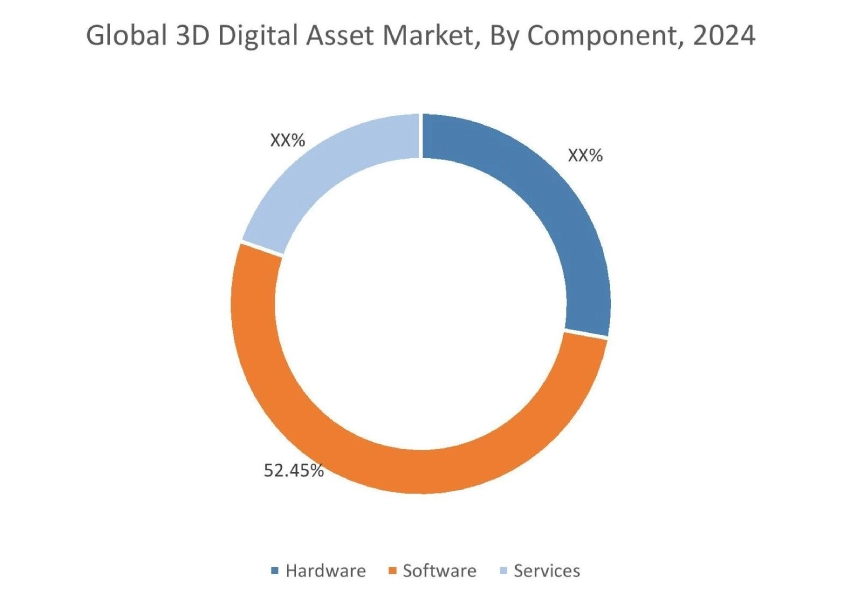
By Deployment:
Based on the deployment, the market is segmented into on-premises and cloud.
Trends in the Deployment:
- The cloud model offers a subscription-based, pay-as-you-go approach, which eliminates the need for significant upfront investments in hardware and infrastructure which in turn drives the 3D digital asset market demand.
On Premise accounted for the largest revenue share in the year 2024.
- Defense, healthcare, and high-end manufacturing, prioritize on-premises deployment to maintain full control over their data in turn driving the market.
- Further, on-premises deployment is often chosen to meet specific industry or governmental regulations that mandate data to be stored and processed within a particular geographic location or a private network which in turn drives the 3D digital asset industry.
- Thus, as per 3D digital asset market analysis, aforementioned factors are driving the market.
Cloud is anticipated to register the fastest CAGR during the forecast period.
- Cloud-based platforms are increasingly integrating AI and machine learning to automate 3D asset workflows.
- Further, cloud deployment enables geographically dispersed teams to collaborate on 3D assets in real time, propelling the 3D digital asset market share.
- Furthermore, enhanced scalability for massive workloads high drives the adoption of cloud services.
- Therefore, based on analysis, automation and optimization, real-time collaboration, and enhanced scalability are anticipated to boost the market during the forecast period.
By Application:
Based on the application, the market is segmented into visualization, gaming & animation, virtual experience, digital prototyping, simulation, marketing & advertising, and others.
Trends in the Application:
- There's a growing advancement in hardware and software, particularly real-time ray tracing which in turn drives the 3D digital asset market expansion.
- The trend is towards more realistic and accurate physics-based simulations. which subsequently propels the 3D digital asset market demand.
Visualization accounted for the largest revenue share in the year 2024.
- AI algorithms automatically optimize lighting, texture mapping, and even generate entire scenes from simple text or 2D image prompts which in turn drive the market.
- Further, growing trend of data visualization with the help of 3D models drives the 3D digital asset market growth.
- Furthermore, growing integration of 3D visualization with augmented and virtual reality is driving the 3D digital asset market growth.
- For instance, 3D Cloud offersdigital asset management platform that provides 3D product visualization for the furniture and home improvement industries. The platform is used by top retailers and manufacturers to efficiently create and deliver high-performing 3D product experiences on a scale.
- Thus, based on analysis,AI-powered visualization, adoption of 3D models, and integration of AR/VR is driving the market.
Virtual Experience is anticipated to register the fastest CAGR during the forecast period.
- 3D models are being used to create highly realistic and interactive virtual training simulations in fields like healthcare, aviation, and manufacturing.
- Further, growing retail and e-commerce sectors are driving the need for virtual experience in turn driving the market growth.
- Furthermore, brands are using AR to create interactive experiences for marketing and advertising which in turn drive the market.
- Therefore, immersive training & education and AR-powered interactive marketing are anticipated to boost the market during the forecast period.
By End User:
Based on the end user, the market is segmented into construction, media & entertainment, manufacturing, healthcare & life sciences, retail & e-commerce, automotive, and others.
Trends in the End User:
- Retail brands are creating immersive, 3D virtual stores where customers can navigate, browse products, and interact with a branded environment which in turn drives the 3D digital asset market.
- There is increasing use of 3D models to visualize anatomical structures, diseases, and complex biological processes for medical education and patient communication.
Construction accounted for the largest revenue share in the year 2024.
- Increasing use of virtual replica of a building or infrastructure to monitor performance, simulate changes, and aid in facility management.
- Further, rising use of augmented and virtual reality for immersive walkthroughs of unbuilt projects, allowing stakeholders to experience the space before physical construction.
- Furthermore, 3D assets are becoming a core component of Building Information Modeling (BIM) which in turn drives the market.
- Thus, as per 3D digital asset market analysis, digital twin technology, AR/VR for visualization, and integration with BIM are driving the market.
Automotive is anticipated to register the fastest CAGR during the forecast period.
- The industry is moving away from expensive physical prototypes by using 3D models to design, test, and simulate new vehicles which in turn drive the market.
- Further, VR is used to conduct immersive design reviews, allowing designers and engineers to experience new vehicles which in turn propels the market.
- Furthermore, 3D configurators allow customers to customize a car's color, rims, and interior, creating a highly engaging shopping experience which in turn drive the market.
- For instance, Siemen offersNX X automotive design software, which customers can leverage for advanced engineering capabilities to create innovative and connected vehicle designs. This multidisciplinary approach helps turn complex projects into a competitive advantage by reducing time to market and improving the overall quality of automotive designs.
- Therefore, based on analysis, digital prototyping and simulation, VR integration, andinteractive 3D car configurators are anticipated to boost the market during the forecast period.
Regional Analysis:
The regions covered are North America, Europe, Asia Pacific, Middle East and Africa, and Latin America.
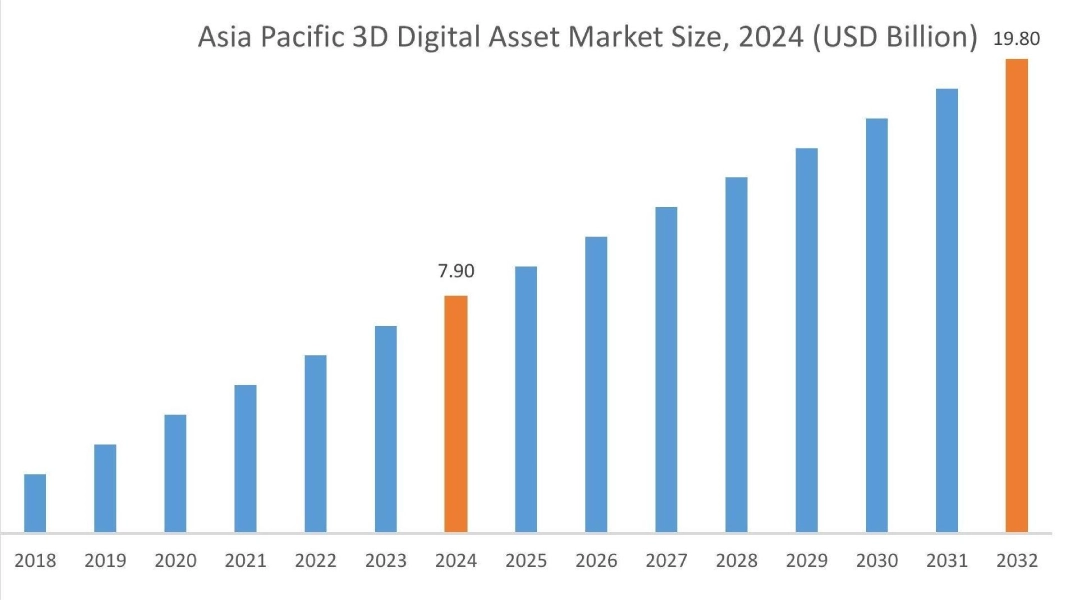
Asia Pacific region was valued at USD 7.90 Billion in 2024. Moreover, it is projected to grow by USD 8.75 Billion in 2025 and reach over USD 19.80 Billion by 2032. Out of this, China accounted for the maximum revenue share of 32.48%. The market for 3D models is mainly driven by booming gaming and e-commerce industries, which have a high demand for immersive digital experiences. Additionally, the increasing adoption of AR and VR technologies across various sectors like education, real estate, and retail also contributes significantly to this growth.
- For instance, according to International Trade Administration, India is projected to have the fastest-growing retail e-commerce market among the 20 largest countries between 2023 and 2027, with a CAGR of 14.1%.
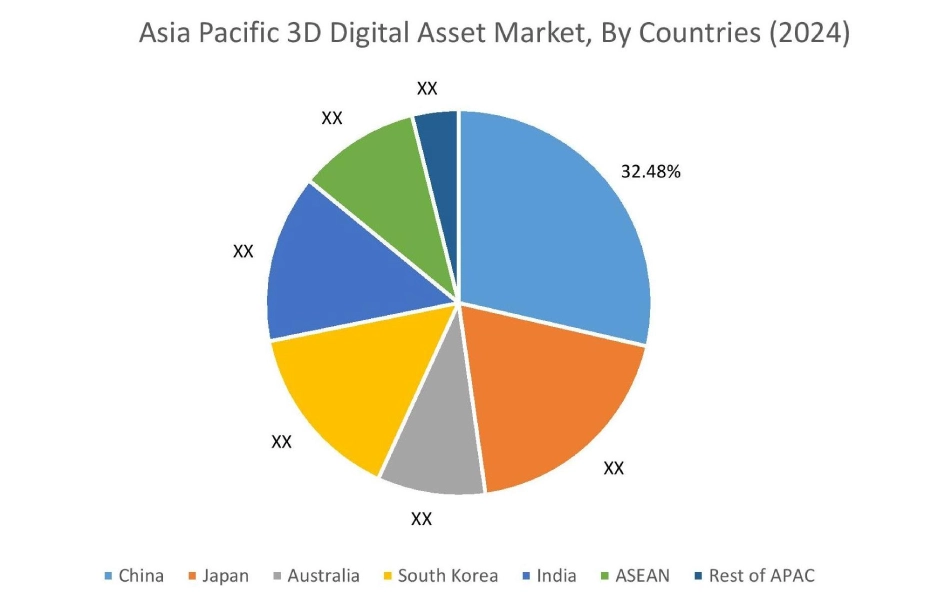
North America is estimated to reach over USD 23.89 Billion by 2032 from a value of USD 9.87 Billion in 2024 and is projected to grow by USD 10.90 Billion in 2025. The North American market is primarily driven by region's strong technological infrastructure and its position as a global hub for the media & entertainment and gaming industries. Moreover, significant investment in advanced technologies like AI, AR, and VR, as well as a culture of innovation, fuels the widespread adoption of 3D digital assets across various sectors.
- For instance, in July 2024, Meta introduced Meta 3D Gen, which is a new, high-speed pipeline for generating 3D assets from text prompts in under a minute. It excels at creating high-quality shapes and textures that are faithful to the prompt. A key feature is its support for physically based rendering (PBR), which allows the assets to be realistic.
The regional analysis depicts that sustained growing architectural, automotive, and media & entertainment sectors in Europe are driving the market. Additionally, factors driving the market in the Middle East and African region are massive investments in infrastructure and construction and rapid digitalization and industrial automation . Further, rapidly expanding gaming and mobile entertainment sectors and increasing internet and smartphone penetration across the region is paving the way for the progress of market trends in Latin America region.
Top Key Players & Market Share Insights:
The global 3D digital asset market is highly competitive with major players providing solutions to the national and international markets. Key players are adopting several strategies in research and development (R&D), product innovation, and end-user launches to hold a strong position in the 3D digital asset industry. Key players in the global 3D digital asset market include-
- Adobe Inc. (US)
- Trimble Inc. (US)
- Microsoft Corporation (US)
- Ansys Inc. (US)
- Sony Corporation (Japan)
- Autodesk Inc. (US)
- Siemens AG (Germany)
- Unity Technologies (US)
- NVIDIA Corporation (US)
- Epic Games (US)
Recent Industry Developments :
Product Launch
In June 2024, echo 3D launched its new 3D digital asset manager (DAM), a centralized platform designed to help companies manage, organize, and share 3D content. The platform provides a suite of tools including a 3D-first content management system (CMS), a content delivery network (CDN), and tools for compression, conversion, and collaboration.
3D Digital Asset Market Report Insights :
| Report Attributes | Report Details |
| Study Timeline | 2019-2032 |
| Market Size in 2032 | USD 69.60 Billion |
| CAGR (2025-2032) | 12.9% |
| By Component |
|
| By Deployment |
|
| By Application |
|
| By End User |
|
| By Region |
|
| Key Players |
|
| North America | U.S. Canada Mexico |
| Europe | U.K. Germany France Spain Italy Russia Benelux Rest of Europe |
| APAC | China South Korea Japan India Australia ASEAN Rest of Asia-Pacific |
| Middle East and Africa | GCC Turkey South Africa Rest of MEA |
| LATAM | Brazil Argentina Chile Rest of LATAM |
| Report Coverage |
|
Key Questions Answered in the Report
How big is the 3D digital asset market? +
The 3D digital asset market is estimated to reach over USD 69.60 Billion by 2032 from a value of USD 28.91 Billion in 2024 and is projected to grow by USD 31.92 Billion in 2025, growing at a CAGR of 12.9% from 2025 to 2032.
What specific segmentation details are covered in the 3D digital asset report? +
The 3D digital asset report includes specific segmentation details for component, deployment, application, end user, and regions.
Which is the fastest segment anticipated to impact the market growth? +
In the 3D digital asset market, cloud deployment is the fastest-growing segment during the forecast period.
Who are the major players in the 3D digital asset market? +
The key participants in the 3D digital asset market are Adobe Inc. (US), Autodesk Inc. (US), Siemens AG (Germany), Unity Technologies (US), NVIDIA Corporation (US), Epic Games (US), Trimble Inc. (US), Microsoft Corporation (US), Ansys Inc. (US), Sony Corporation (Japan) and others.
What are the key trends in the 3D digital asset market? +
The 3D Digital Asset market is being shaped by several key trends including increasing demand for immersive experiences in gaming, proliferation of virtual and augmented reality, and the growing integration of AI and machine learning.
